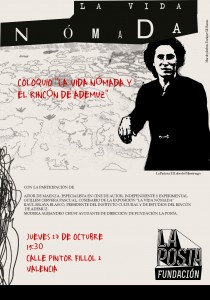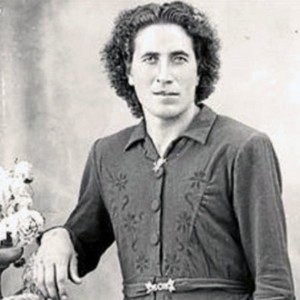Nomadic life has its landscapes, such as those that can be seen in the exhibition “The Nomadic Life”. In the cities: under the bridges, or old obsolete industrial areas where wild nature has returned, like those recorded by Joost Conijn in the audiovisual “Siddieqa, Firdaus, Abdallah, Soelayman, Moestafa, Hawwa in Dzoel-kifl”, made in Amsterdam; or those that Denis Ponté has photographed: “Nomadic Community Garden” and “Left for Dead”, made in London and New York. Also open field landscapes: refuges in the mountains, and desolate places where no one would look for you, like those photographed by Ulrike von Gültlingen: “Hohrodberg”, military buildings in Alsace; or the sea of stones of Arroyo Cerezo (Rincón de Ademuz) that the geologist Enrique Gil Bazán has studied, and that we show in “The Nomadic Life” on a research wall.
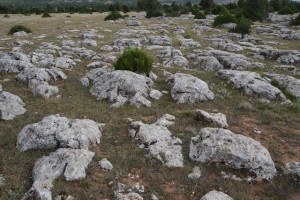
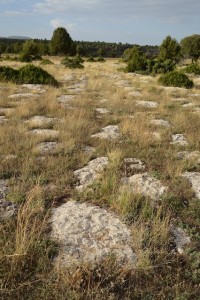
Sea of stones of Arroyo Cerezo (Rincón de Ademuz)
We are going to talk about all this, focusing our attention on the sea of stones of Arroyo Cerezo (Rincón de Ademuz), which catches us closer, and because it is a box of surprises, due to the number of suggestions it generates, both literary (The Anabasis or Expedition of the Ten Thousand, by Xenophon; Giovanni Papini: Gog, in particular the chapter “Corpses of cities”), as cinematographic: the American western (in particular: “Westward the Women”, 1951, by William A. Wellman); Eric Baudelaire: “L’Anabase de May et Fusako Shigenobu, Masao Adachi et 27 années sans images”, 2011; Ben Rivers and Oliver Laxe: “The Sky Trembles and the Earth Is Afraid and the Two Eyes Are Not Brothers”; also plastic: Robert Smithson: “A tour of the monuments of Passaic, New Jersey”; etc.

Remains of the Maquis found in the mountains, in shelters and caves
In addition, the Rincón de Ademuz and the entire region in which it is located, constituted by the plateau it includes the Sierra de Gúdar, the Sierra de Javalambre, the Montes Universales, the Sierra de Albarracín, and beyond, is a territory with nomadic life story. The most recent, in the 20th century, was constituted by the Maquis, the anti-Franco guerrilla that had been operating since the end of the 1936-1939 Civil War (even more so since the end of World War II, when fighters, members of the French Resistance, many of them spanish republicans who fled to France after the defeat in the Civil War, who did not surrender their weapons in France at the end of the war and joined the Maquis), whose activity would last until the end of the 1950s (although sources disagree, in this point). And before, in the 19th century, we have to refer to the successive Carlist wars, of the supporters of the brother of Ferdinand VII who, upon his death, confronted his successor, Queen Elizabeth II of Spain, and before his mother Regent María Cristina, during her minority. Some wars that, up to three in number, pitted conservatives against liberals, among whom the most radical carried out the confiscation of the assets of the Catholic Church and the disassociation of the noble estates, appropriating the immense ecclesiastical properties and of the nobility, while turning the farmers, serfs and vassals into day laborers, without noticing the consequences that this change would bring to already weak family economies. The Carlists also lived and fought wandering for these lands to which we are referring. And before, in the 17th century, when the border air that characterized this territory for centuries was still breathed, as long as it took the Christians to (re)conquer these lands from Islam, this was the territory of warlords (to use the expression that became popular during the war in the former Yugoslavia), who in behetry fought for their own benefit, seeking to increase their domains and their heritage by assaulting neighbors and passers-by. The one who caused the most havoc was Jaime Ruiz de Castellblanch, who is said to have carried out 183 murders, kidnappings, rape, counterfeiting currency, etc., displaying unlimited violence. The nomadic life is not always that romantic idea that is usually had. Many times it is not far from the classic stories full of violence, such as the Iliad or the Odyssey, on which the epic literary genre has been built.
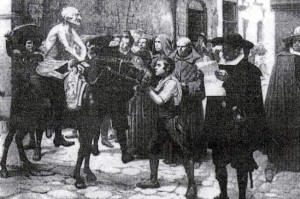
Lithograph with the representation of Don Jaime Ruiz de Castellblanque, Lord of Torrebaja (Rincón de Ademuz), on his way to the gallows in the Plaza Mayor of Madrid, where he was executed on February 14, 1672.
To talk about all this we are going to have the presence, in addition to the public, whom we invite from now on to contribute their suggestions; They will also be with us:
- - Aitor de Maenza, specialist in auteur, independent and experimental cinema;
- - Raúl Eslava Blasco, president of the Rincón de Ademuz Cultural and Studies Institute;
- - Guillem Cervera Pascual, curator of the exhibition “The Nomadic Life”;
- - Alejandro Chust, assistant director of Fundación La Posta, moderating the discussion.
We will take advantage of the occasion to, at the request of our followers, explain where the image of the person who illustrates the poster for the exhibition “The Nomadic Life” comes from, as well as the flyer prepared to invite this colloquium, who can be guessed as someone of intermediate gender, and it is said that he was called, alternatively, La Pastora / The Wolf of The Maestrazgo. We will simply advance, that he led a nomadic life in the region to which we are referring, of which the Rincón de Ademuz is part, which more or less coincides with the scope of the AGLA (Guerrilla Association of Levante and Aragón), having achieved popularity thanks to the novel by Alicia Giménez Bartlett: Where nobody finds you, 2011 (which is said to have been inspired by the novel by Manuel Villar Raso: La Pastora, the maquis hermaphrodite, from 1978, which at the time went unnoticed). Who is this man/women?
